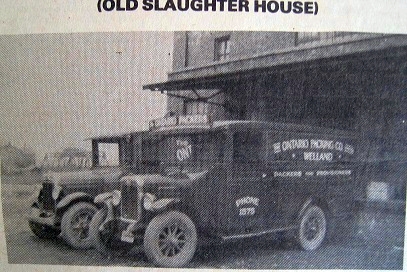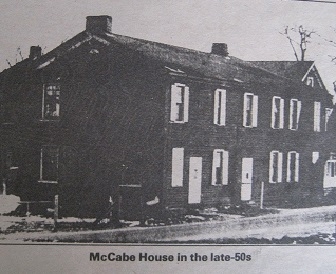By David l. Blazetich, from the files of his grandfather George “Udy” Blazetich
[Date Unknown]
In 1913, the Laughlin realty Company produced an advertisement to promote its interest in selling land in Welland. Large and obviously designed to promote the company’s expansion in Welland, the circular nevertheless contained much information of historical value and some now-rare photographs.
Under very large, major headings such as: “Why Welland Grows”, “Railroads and Banks”, and $50,000.000is being spent on the New Welland Canal and Welland Has Made Good”, the circular gave detailed information and a map outlining industries and points of interest in Welland, a city that is today making history.
It goes on to praise the “factories that have sprung up and are running where a year ago were vacant commons. New paved sidewalks have been paid out and completely built up. Main business and residence streets are paved. A street railway was absolutely needed and built in several months-now in operation. And this growth will keep on. More homes are right now needed for workmen coming to locate.”
It confidently predicted “Welland is destined to become one of Canada’s greatest industrial centres,” and “with its several railroads connecting it with cities like Buffalo, Hamilton and Toronto clustered around it-with its power at rock bottom price-its cheap natural gas-with the new $50,000,000 canal, there is absolutely nothing to hold back Welland’s growth.”
Specifically promoting the Manchester Park development, it asked: “What would it have meant to have bought several lots in Toronto a few years ago as close to Young Street as Manchester Park is to the Post Office in Welland- -10 minutes’ walk? The article said, “Many men in Welland have grown rich during the past few years” and “A lot or two bought now will double in value in a very short time. There is no safer investment. There is no safer investment. There is no better buy.”
All you needed was 10 per cent of purchase price (cash in hand). When the price was $200 per lot, $10 per month on one lot, and $5 per month on each additional one. When the price of the lot was under $200, $5 per month would carry it.
Manchester Park was touted as the “most favourably located subdivision in Welland today-adjacent to the great Empire Cotton Mills, Bemis Bay Company, Canada Forge Company, Chipman Holten Knitting Mills, Supreme heating Co., Goodwillie and Sons Canning Factory, Lambert’s Planing Mills, Duck Fabric Company and Welland Machine and Foundry.”
A detailed street map was included with a “Key to Industries.” A guide to the “points of Interest in Welland’ directed the reader to 23 highlights, from the Water Works Pumphouse to the public school to the Laughlin Realty Company Ltd. Office, the turning basin of the Welland Canal and the Temple Club.
Although the article is a blatant {and probably expensive, for its time} advertisement of the company, the information and photographs present an emerging community of 9,000 with 25 operating industries and a Dominion government-financed canal with a $50,000,000 price tag and “work…now under way.” With seven railroads, Welland was absolutely the best town for shipping conveniences in Canada.”
(OLD SLAUGHTER HOUSE)
By David l. Blazetich, from the files of his grandfather George “Udy” Blazetich
[Date Unknown]

A long time ago, the residents of 7th Street, in Crowland, were often disturbed by the unpleasant sounds and smells emanating from the Ontario Packing Plant, affectionately referred to as “The Old Slaughter House”. One consolation, however, was that the neighborhood could purchase fresh meat at cost price on the slaughter house premises.
The Ontario Packing Plant was opened on August 19th, 1922 with Frank Ahman as its president. Among the first employees, brought in from Kitchener, were many Senior A hockey players including well-known Art Barlett of the Kitchener-Waterloo Dutchmen.
The Old Slaughter House later became the home of Stan Reid’s used automobile dealership and, still later, Sunnyside Dairy, which is still owned and operated by Al lan Pietz, M.L.A.
lan Pietz, M.L.A.
In the accompanying photographs, note in the background the swing bridge (Black Bridge) at the foot of Sixth Street, and the McCabe House, the subject of a previous article by this writer.
*Note also the present owner of Sunnyside Dairy as depicted in 1954 with his father, Deputy Reeve Paul Pietz of Humberstone Township, Warden in 1952. At that time, his son, Deputy Reeve Allan Pietz at 24, was the youngest man ever to serve on Welland County Council. They were the first father and son combination in the history of Welland County Council.
Part 1
By Lara Blazetich, from the files of her grandfather George “Udy” Blazetich
*Information courtesy of Marguerite Shefter Diffin
[Welland Tribune, 1991]
 Shown to the right is the McCabe Hotel in the late 1850s, just before it was demolished. The original structure was built in Crowland in 1850 by James Tufts, Miss Addie McCabe’s great –grandfather.
Shown to the right is the McCabe Hotel in the late 1850s, just before it was demolished. The original structure was built in Crowland in 1850 by James Tufts, Miss Addie McCabe’s great –grandfather.
The hotel was operated by Tufts and his wife, Charlotte (Brailey) for many years. Three generations have been born within its walls. The hotel was located at 25 Canal Bank in Crowland Township, just south of the railway tracks adjacent to the railway bridge spanning the canal.
When the hotel was built it had a six-post veranda, upper and lower, across the front on which was draped a large sign lettered “The Travellers Home.” On one end of the sign was printed a picture of a stage coach and horses, and on the other end a picture of the Tow Horses. These horses were used to pull the barges in the canal. A large ballroom on the second floor was a popular haven for residents who attended dances and other functions held in the hotel.
Tufts owned 1,000 acres of land, 500 acres of forest, and 500 acres of marshland. He employed 10 escaped slaves from the South as woodcutters, selling the wood to passing boats and trains.
One of the slaves was Jim Wilson, who was later married in the McCabe home. Many hunters stayed at the hotel during the hunting season and hunted in the nearby marshland. James Tufts came from Mallorytown near Brockville. He descended from Peter Tufts, who was born in England in 1616 and came to America and lived in Charlestown prior to 1638. He married Charlotte, daughter of Elia and Leah (Morris) Brailey, who moved to America about 1686 from York, England.
The Brailey original homestead was located at Doans Ridge in Crowland, and they operated a hotel that was situated just west of Diffins Coal Dock (now a seniors centre).
The demolished hotel was actually on the canal waterway, before the canal was widened.
The Tufts family name was, and still is prominent in the history of Crowland. James Tufts married Charlotte Brailey. And son Wallace married Maria Hanna. Wallace and Maria had eight children: Emerson, George, Beatrice, Addie, Rena, Elva, Stanley and Curtis.
J.C. Diffin, mayor of Welland in 1921, married Elva Tufts and she was the mother of Harry Diffin, who was also the mayor of Welland from 1948-50. Diffin was also selected as Man of the Half Century in 1987.
He served 31 years and six months on Welland city council.
Sarah Tufts, daughter of James, married J. McCabe, and their daughter Addie, who never married, operated the McCabe House for many years.
DOWN MEMORY LANE – CROWLANDS’S MISS ADDIE McCABE (1954)
Part II
By Lara Blazetich, from the files of her grandfather George “Udy” Blazetich
*Information courtesy of Marguerite Shefter Diffin
[Welland Tribune, 7 February 1991]
The following is an exclusive interview conducted by Norman Panzica, former Tribune staff reporter, with Crowland’s remarkable citizen, Miss Addie McCabe.
The tiny old lady sat perfectly still as Addie put the finishing touches on her regular chore of hair combing. In the next room several men sat smoking, some of them not moving or speaking.
Just off the room where they sat, a blind man enjoyed the music from a radio from his room.
In the living room, a cerebral palsy victim sat as though in silent conversation with an old gentleman across from him. Upstairs in a bedroom, a man who had been on crutches for nine years waited patiently for the time Miss McCabe would bring a full dinner tray to him.
The guests, 25 in all, and all pensioners reside in McCabe House, a building more than a century old at 25 Canal Bank Rd., just south of the subway under the New York Central Railway.
For the lodging and care, they pay what works up to $8.30 a week. Each gives Miss McCabe his or her monthly $40 pension cheque and $4 is returned.
McCabe House is a huge structure containing many remnants of an era when gentlemen drank sherry, from dew drop-shaped decanters, and canal horses were stabled between periods of pulling boats along the canal.
“Travellers Home,” as it was known, boasted specially-made walnut furniture, and its patrons rested their elbows on a solid walnut plank more than 10 feet long and four inches thick. The cupboards, which held liquors on display, are now carry-alls. The shirts and underclothing of pensioners hang from the lines in the ballroom where gala dances were held before the day of the phonograph.
Where fashionable hunters once tossed reins to a stable boy, a 1954 transient asks for and gets a night’s lodgings and a substantial meal. At least four radios, a piano, and an organ entertain the residents. In one of the sitting rooms a Bible rests open on a stand.
From this point, prayer meetings are held each Thursday evening for those interested.
In nearly all of the 22 rooms, clean cots and beds of various sizes are to be found. Everywhere cleanliness is pronounced.
Miss McCabe, who does all the cooking, employed two house-keepers. Evening snacks among the “guests” were quite common.
Miss McCabe during the early 1930s, was employed as a cook at the Station Hotel operated by the Fred Kilgour family. This was confirmed by Katie Kisur Martin, who also worked at the hotel. Miss McCabe is a truly remarkable woman and surely deserving of the warn gratitude of the community for a noble aim in life-that of doing good unto others.
A labor of love and with devotion-at the old McCabe House.
Miss McCabe’s two sisters, Jessie Niger, from New York City and Charlotte Twomey, were regular visitors at the McCabe House. A relative, Kevin Twomey, resides in Fenwick.
Miss McCabe was born in 1879 and died in 1963 at the age of 84.
 Subscribe..
Subscribe..

 lan Pietz, M.L.A.
lan Pietz, M.L.A. Shown to the right is the McCabe Hotel in the late 1850s, just before it was demolished. The original structure was built in Crowland in 1850 by James Tufts, Miss Addie McCabe’s great –grandfather.
Shown to the right is the McCabe Hotel in the late 1850s, just before it was demolished. The original structure was built in Crowland in 1850 by James Tufts, Miss Addie McCabe’s great –grandfather.